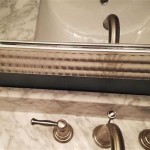How to Take Out Hair Dye From a Bathroom Sink
Hair dyeing is a common practice. However, accidental spills and splatters on bathroom surfaces, particularly sinks, are frequently encountered issues. Hair dye, due to its potent pigmentation, can quickly stain if not addressed promptly. This article provides comprehensive methods for removing hair dye stains from bathroom sinks, outlining various cleaning agents and techniques applicable to different sink materials and stain severities. The goal is to present information needed to effectively remove these stains while minimizing the risk of damage to the sink surface.
Before commencing any cleaning process, it is imperative to identify the material of the sink. Common bathroom sink materials include porcelain, ceramic, stainless steel, acrylic, and composite materials. Each material reacts differently to cleaning agents. Using an abrasive cleaner on a sensitive surface like acrylic may cause scratches and dullness. Conversely, a mild cleaner may be ineffective on a durable surface like porcelain with a stubborn stain. Understanding the sink’s composition allows for the selection of the most appropriate and effective cleaning method.
Furthermore, it is crucial to assess the severity and age of the stain. Fresh stains are generally easier to remove than older, set-in stains. Fresh stains can often be addressed with milder cleaning solutions, limiting the need for harsher chemicals. Older stains, however, may require more aggressive cleaning agents and repeated applications. The age of the stain is thus a crucial factor in determining the required cleaning approach.
Initial Steps and Precautions
Prior to applying any cleaning agent, protect the surrounding areas of the bathroom sink. Cover nearby surfaces like countertops, mirrors, and floors with drop cloths or towels to prevent accidental splatters or damage. Wearing gloves is also recommended to protect hands from harsh chemicals and potential skin irritation. Furthermore, it is crucial to ensure adequate ventilation in the bathroom by opening windows or using a ventilation fan. This minimizes the inhalation of potentially harmful fumes from cleaning products.
Start by wiping away any excess dye with a clean, damp cloth. Avoid scrubbing, as this can spread the stain and potentially drive the dye deeper into the sink material. Gently blot the area to absorb the excess dye. This initial step removes loose dye particles and prepares the surface for further cleaning.
After blotting, rinse the affected area with warm water. This helps to loosen any remaining dye and allows for a better assessment of the stain’s severity. Examine the sink closely to determine the extent of the staining and choose the appropriate cleaning method accordingly. If the stain appears light, a mild cleaning agent may suffice. If the stain is dark and persistent, a more potent solution may be needed.
Mild Cleaning Agents and Techniques
For fresh and light hair dye stains, a mild dish soap solution can be effective. Mix a few drops of dish soap with warm water and apply the solution to the stain using a soft cloth or sponge. Gently scrub the area in a circular motion, then rinse thoroughly with warm water. Repeat the process if necessary. Dish soap is generally safe for most sink materials and can effectively remove minor stains without causing damage.
Another readily available mild cleaning agent is baking soda. Mix baking soda with water to form a paste. Apply the paste to the stain and let it sit for 15-20 minutes. The baking soda acts as a mild abrasive and helps to lift the dye from the surface. After the allotted time, scrub the area gently with a soft cloth or sponge and rinse thoroughly with warm water. Baking soda is a versatile cleaner that is safe for most sink materials and can effectively remove various types of stains.
A paste of cream of tartar and hydrogen peroxide can also be used for mild stains. Mix equal parts of cream of tartar and 3% hydrogen peroxide to form a paste. Apply the paste to the stain and allow it to sit for 30 minutes to an hour. The hydrogen peroxide helps to bleach the stain, while the cream of tartar provides a mild abrasive action. After the allotted time, scrub the area gently with a soft cloth or sponge and rinse thoroughly with warm water. This method is best suited for white or light-colored sinks, as hydrogen peroxide can potentially lighten darker surfaces.
Stronger Cleaning Agents and Techniques
For more stubborn stains that do not respond to mild cleaning agents, stronger solutions may be required. However, it is crucial to proceed with caution and test the cleaning agent on an inconspicuous area of the sink first to ensure it does not cause damage or discoloration.
One effective option is using a commercially available bathroom cleaner specifically designed for stain removal. These cleaners often contain stronger solvents and chemicals that can effectively dissolve hair dye stains. Follow the manufacturer's instructions carefully and wear gloves and eye protection when using these products. Apply the cleaner to the stain, let it sit for the recommended time, and then scrub the area gently with a non-abrasive sponge or cloth. Rinse thoroughly with warm water.
Another option is using rubbing alcohol (isopropyl alcohol). Apply rubbing alcohol to the stain with a cotton ball or cloth. Let it sit for a few minutes, then gently scrub the area. Rubbing alcohol is a solvent that can dissolve various types of stains, including hair dye. However, it is important to use caution when using rubbing alcohol on certain sink materials, as it can potentially damage the finish. Always test it on an inconspicuous area first. Additionally, ensure adequate ventilation when using rubbing alcohol, as it can emit flammable vapors.
A more aggressive approach involves using a diluted bleach solution. Mix one part bleach with ten parts water. Apply the solution to the stain and let it sit for no more than 5-10 minutes. Bleach is a powerful bleaching agent that can effectively remove even the most stubborn stains. However, it is crucial to use extreme caution when using bleach, as it can damage certain sink materials, especially colored sinks. Always test the solution on an inconspicuous area first. Wear gloves and eye protection, and ensure adequate ventilation. Rinse the area thoroughly with warm water after application to remove all traces of bleach.
Techniques for Specific Sink Materials
As previously emphasized, the sink material dictates the appropriate cleaning methods. For porcelain sinks, which are generally durable, most of the aforementioned cleaning agents can be used. However, avoid using abrasive cleaners or scouring pads, as they can scratch the surface. For ceramic sinks, which are also relatively durable, similar guidelines apply. Avoid using harsh abrasives that can damage the glazed finish.
Stainless steel sinks are susceptible to scratches, so avoid using abrasive cleaners or steel wool. Use a non-abrasive cleaner specifically designed for stainless steel. Wipe the sink in the direction of the grain to prevent streaks. For acrylic sinks, which are more delicate, use mild cleaning agents and avoid harsh chemicals or abrasive cleaners. Acrylic sinks are easily scratched, so use a soft cloth or sponge for cleaning. Composite sinks, which are made from a blend of materials, require careful cleaning. Refer to the manufacturer's instructions for specific cleaning recommendations. Avoid using harsh chemicals or abrasive cleaners that can damage the composite material.
Regardless of the sink material, thorough rinsing is always crucial after applying any cleaning agent. This removes any residual cleaner and prevents potential damage or discoloration. Use warm water and a clean cloth to rinse the area thoroughly, ensuring that no traces of the cleaner remain. After rinsing, dry the sink with a clean towel to prevent water spots.
Removing hair dye stains from bathroom sinks requires a systematic approach, starting with identifying the sink material and stain severity. Selecting the appropriate cleaning agent and technique based on these factors is crucial for effective stain removal without causing damage to the sink. Consistent preventative measures, such as promptly cleaning up spills and using protective barriers, can significantly reduce the likelihood of future staining.

How To Get Hair Dye Off Your Sink Tub Or Shower

How To Remove Hair Dye From Your Sink And Other Bathroom Surfaces Hometalk

How To Remove Hair Dye From Sink Get Those Stains Off

How To Remove Hair Dye Off A Bathroom Sink

How To Get Hair Dye Off Sinks 6 Super Easy Ways

How To Remove Hair Dye From Sink Design Swan

Remove Hair Dye From Sinks And Countertops With Bar Keepers Friend Removal Cleaning S Clean Sink

How To Remove Hair Dye Stains From Bathroom Sink No Scrubbing Works Like Magic Removal Removing Black Diy Remover

How To Remove Hair Dye From Your Sink And Other Bathroom Surfaces Hometalk

How To Remove Stains From A Porcelain Sink Isavea2z Com
Related Posts







